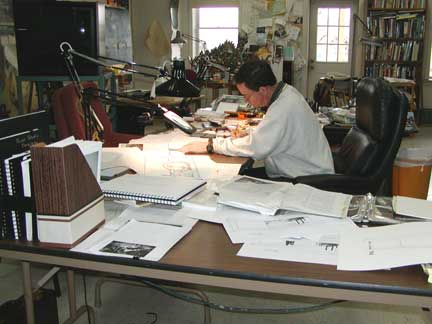
Research for the River Campus Mural has begun. When I first received the commission to create a mural for the new School for the Visual and Performing Arts, to be known as the River Campus, my thoughts were to tell the history of the Mississippi River. Located on the banks of the Mississippi, the new campus will be perfect to reflect a river theme. In addition, the mural will be placed next to the entrance of the regional history museum which will reflect Cape Girardeau's and the southeast Missouri region's legacy with the Mississippi River. After hours with a pen and my sketchbook, I had pages of subjects and events. It was obvious that a total history would not fit within the area I had to work. The theme had to be scaled down.
I have to admit, this was the first time a project of this nature has caused me to lose sleep. My first thoughts were that I needed something new and spectacular - a "reinvent the wheel" process for my work. As I worked in my studio, shown below, surrounded with notes, I struggled to simplify the river theme for the space in which I had. The subject of the Mississippi River and its relationship to the juncture of Cape Girardeau is a grandiose undertaking.

Rather than focus on the extensive lists of subjects, events, and personalities of the river, I choose to focus on the basic travelers of the river. Starting with the Mississippian culture 600ad - 1250ad, I chose to progress through the flatboat and keelboat men of the 18th and 19th century, the 19th century steamboat which is the historic subject most of us identify as the embodiment of the inland waterways, and finally today's navigation with historic river travel represented by the Delta Queen and the modern power of towboats.
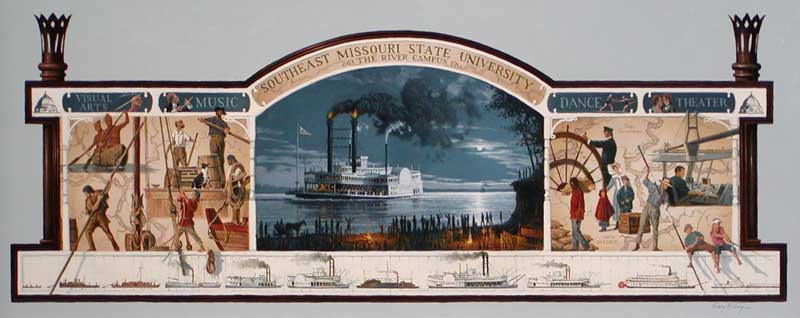
I felt that the centerpiece for the mural should be a subject that represented the pinnacle of the Mississippi River in terms of its historic importance. In my opinion, the event that embodied the grand age of the rivers was the Great Steamboat Race of 1870 between the Robt. E. Lee and the Natchez. This race found two huge 300ft steamboats racing all out up the Mississippi River from New Orleans to St. Louis at speeds up to 23 mph. The event was our country's first media event as huge sums of money were wagered, large crowds traveled considerable distances to line the banks of the river, and the new telegraph broadcast the progress of the race to a national audience. The Robt. E. Lee at 10:45pm was noted to have passed a huge assemblage illuminated by bonfires along the banks of the river at Cape Girardeau. My depiction of the grand steamboat passing Cape Girardeau with fire visible from her chimneys reflects the emotion and grandure that would have been invoked on the citizens of Cape Girardeau at that time. An artist's note at this time: I make my best effort to create works of art that reflect an accurate historic event. The viewer will see the Natchez a close distance behind the Robt. E. Lee. In reality, the Natchez would have been much farther behind and not in view. As an artist, I chose to be creative and make a race of it. You can't have a race without both parties in view.
The areas to the left and right of the centerpiece will reflect the travelers of the river. To the far left we find an image representative of the Native-Americans that traveled extensive distances thoughout North America to trade. For thousands of years before the railroads developed in the mid 19th century, the only highways we had were the inland waterways. Also, on the left side of the composition, I have represented river travel before steam. Flatboat men and keelboat men used the sail, oar, paddle, and rope to pull and propel their vessels. To the right of the center image the great wheel of the steamboat with pilot at the helm are universal images of the 19th century addition of steam power to the rivers. Below, the figure carrying a sack of grain represents the commerce of the rivers and the women and her children represent the extensive passenger travel that took place before the development of the railroad. To the far right we see the view from the pilot house of a modern river vessel, the new bridge at Cape Girardeau, and two kids catching the big one. These images are superimposed over a 1797 map of the Mississippi River. Note to the left the Missouri River flows past St. Charles and the Illinois River empties into the Mississippi River. The map flows through the composition across the banner arch and down the right side past Cape Girardeau and New Madrid. Below these images, I have depicted an historic time line of the vessels of the Mississippi River. Starting to the left I progress through the early dugout canoes, flatboat, keelboats, early steamboats such as the New Orleans 1811, the Yellowstone 1831, the Arabia 1856, the civil war ironclads, the J.M. White in the 1870's, the Cape Girardeau in the 1880's, the Delta Queen built in 1924 and still in use, and the towboats of today. In honor of the new facility for the performing and visual arts, the ovals along the top to the left and right will depict a representation of the visual arts, music, dance, and theater. The mural will also be a combination of painting and sculpture. The symbolism of the total work reflects that of a steamboat. From the chimneys to each side, the decorative posts in the center, the boarded exterior of the steamboat along the bottom, the four oval areas depicting the arts are symbolic of the marques displayed on the foreward areas of steamboats to list their port of call, and finally the arch in the center of the mural is symbolic of the arch wheel covering the great side wheelers of the river. The location was often used to display the name or partial identity of the vessel. I choose to list the identity of the institution that was making the River Campus dream come true, Southeast Missouri State University.
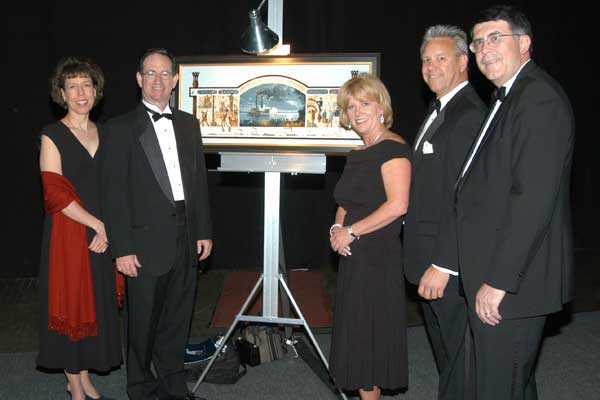
The model was completed and unveiled at The President's Council Dinner in April. Shown here with me are Sandy, Mr. and Mrs. Jerry Zimmer, and Dr. Ken Dobbins, President, Southeast Missouri State University.
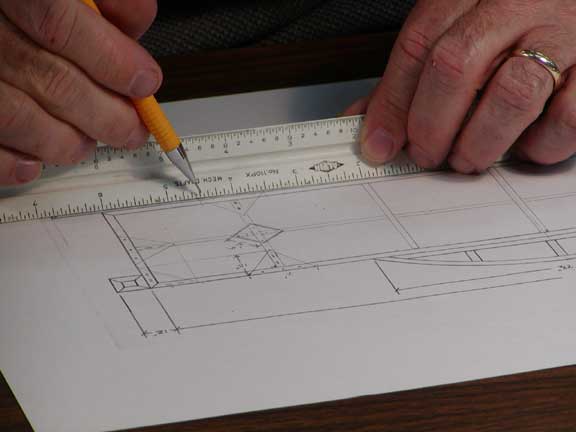
The study is now complete; and, it's time to begin work on the canvas stretcher system that will support the mural. I am going to paint the mural in my studio. It will then be shipped to Cape Girardeau and installed at the new River Campus. I paint my murals on large canvas strechers because after studying murals which were painted directly on the walls, I have found that a great deal of murals are lost over time. It is either to expensive or impossible to remove the work when the buildings are no longer useful. Thus, they are lost. My hope is that the development of a portable stretcher system will allow the work survive as long as possible.
The drawings above are the beginning of the construction process. Accuracy is a must.
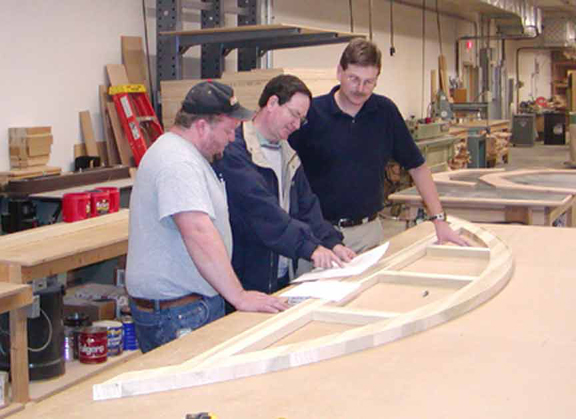
In order to get the most accurate workmanship for the molding used in the frame work, I went to best. Above I am talking with Jim Tobben and Rick Wahle of Wahle's Wood Working in Union, Missouri. I can't begin to tell you about the quality of product that these people can produce. They specialize in radius cuts. They did a marvelous job on the arch for the top of the canvas.
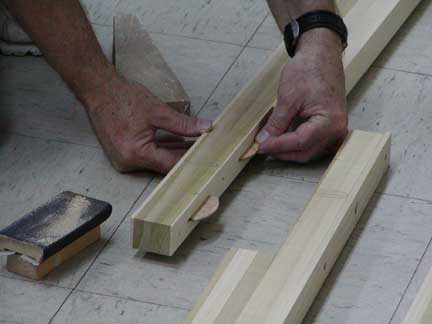
They used laminated poplar for the main body of the frame to insure strength and accuracy. The 24' upper and lower sections were spliced into 12' pieces. I glued and screwed the two together in my studio.
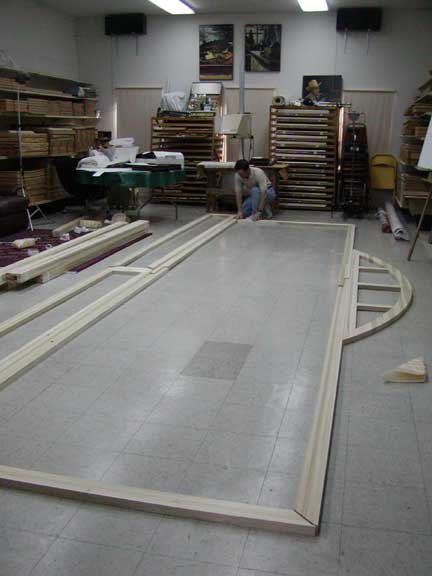
This is a big day for me. I am able for the first time to actually see the full size of the job before me.
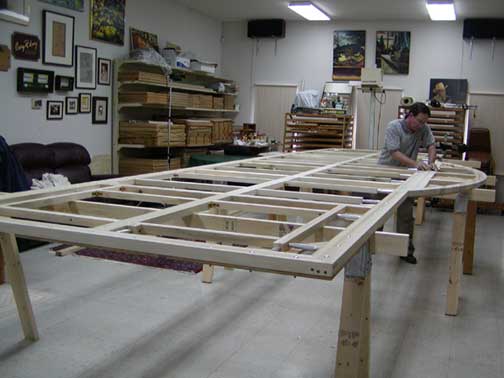
In the late 70's, I completed a mural for the West Plains Bank in West Plains, Missouri. And, in the early 80's, I completed a mural that hangs in the Washington, Missouri Public Library. I am using the same techinques for this mural as I did for the early works.
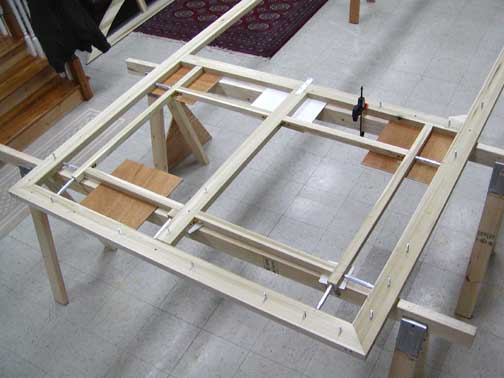
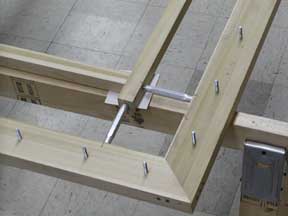
The reason for the extensive network of cross members is strength and there must be a way to expand the canvas stretchers as work proceeds. As I work on a very large piece of canvas, the constant pounding of the painting process and the constant addition of weight from the paint will cause the canvas to become loose and floppy. There must be a way to adjust the tautness of the canvas. In the above image, you will see turnbuckles that have had the ends, hooks and rings cut away. Look closely in the corners, see the detail to the right, and along the perimeter a few feet from the corner. These turnbuckles are used to push the frame apart in order to tighten the canvas. The bolts sticking through the frame will run through slotted expansion joints. Note the plywood corners below.
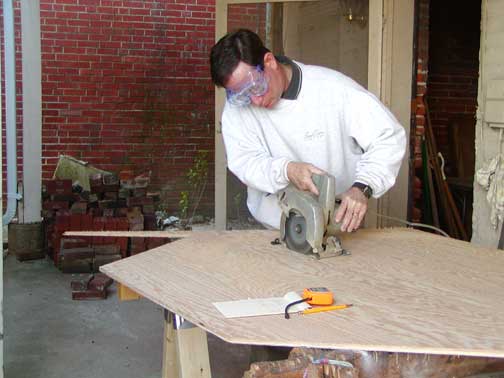
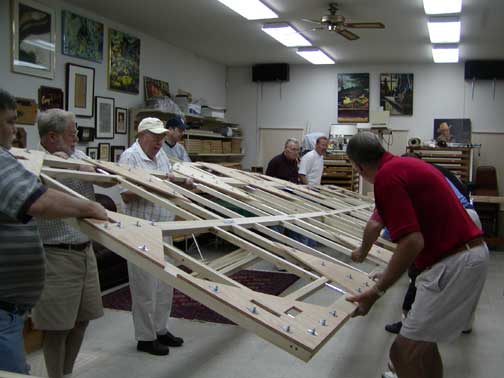
This part of the canvas stretcher system is complete. I had to build the stretcher on its face. Time to turn the stretcher system over so that the canvas can be stretched on the frame.
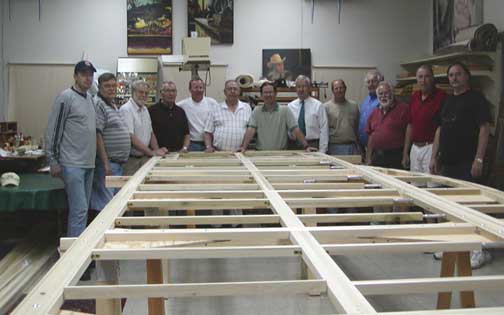
I do feel so honored and blessed to have so many friends in Washington, Missouri that believe in my work. These fine friends are mainly part of the men I have coffee with each morning at Cowan's restaurant. Ask and they will come. Left to right: Brian Gansereit, Gary Gansereit, Gene Brez, John Carter, Doug Kleekamp, Paul "Pepe" LaPlant, Me, Sid Thayer (Sid is a lawyer, the reason for the tie, but we won't hold that against him, after all he was the first to show that day), Gary Kleekamp, Terry Briggs, Al Westrich (Al is the gentleman that modeled for the man standing in the boat in my painting entitled: "Eating Up the Lights"), Frank Wood, and the all knowing, all seeing Roger "High Road" Langendoerfer.
The mural is ready for the canvas to be stretched. Please see my next entry into the Mural Journal.
All the best to you,
